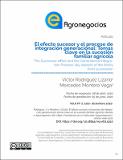Mostrar el registro sencillo del ítem
El efecto sucesor y el proceso de integración generacional: Temas clave en la sucesión familiar agrícola
| dc.creator | Rodríguez Lizano, Víctor | |
| dc.creator | Montero Vega, Mercedes | |
| dc.date.accessioned | 2021-02-10T18:16:24Z | |
| dc.date.available | 2021-02-10T18:16:24Z | |
| dc.date.issued | 2020-06 | |
| dc.identifier.citation | https://revistas.tec.ac.cr/index.php/eagronegocios/article/view/5210 | |
| dc.identifier.issn | 2215-3462 | |
| dc.identifier.uri | https://hdl.handle.net/10669/82791 | |
| dc.description.abstract | Este estudio examina el efecto sucesor y el Proceso de Integración Generacional (PIG) con el fin de aportar información relevante en el camino de entender mejor la sucesión generacional agrícola. El estudio se llevó a cabo en fincas hortícolas familiares en Zarcero, Costa Rica. Se realizaron 126 encuestas en finca entre enero y mayo de 2019. Para cuantificar el efecto sucesor, se generaron tres perfiles de finca según probabilidad de sucesión (baja, media y alta). Así mismo se cuantificó el comportamiento de la producción para cada finca en los últimos cinco años (disminuido, igual, aumentado). Esto permitió a través una prueba chi cuadrado determinar el comportamiento de la producción de las fincas según su probabilidad de sucesión. Por otro lado, se acotó el PIG a seis acciones claves identificadas en la literatura. Dichas acciones se cuantificaron y se corrieron dos modelos por medio de Mínimos Cuadrados Ordinarios (MCO), en los cuales se utilizaron variables socioeconómicas y psicológicas como factores independientes. Con respecto al efecto sucesor, se encontró que fincas que presentan un sucesor claramente definido (probabilidad de sucesión alta), son más propensas a presentar incrementos de su producción que aquellas que por el contrario no poseen un sucesor claro o cuyo estado de sucesión aún no está definido. Con respecto al PIG, el género del sucesor y variables proxy de riqueza poseen los coeficientes más altos dentro de las variables socioeconómicas que explican el PIG. Se observa que la variable psicológica “intención” es la que mayor correlación presenta con el PIG y una de las que mejor explica el mismo. Se demostró por lo tanto, que poseer un sucesor identificado es clave para la competitividad y sostenibilidad de las fincas familiares. Así mismo, el enfoque tradicionalista donde se trata de explicar el PIG o la sucesión por medio de variables socioeconómicas, arroja valores bajos de explicación (R2:0,45) debido a su enfoque reduccionista. Los hallazgos dan paso a una nueva tendencia de investigación relacionada, donde las variables psicológicas, culturales y la economía conductual parecen ser opciones novedosas y las más atinentes al tema.. | es_ES |
| dc.description.abstract | This study examines the successor effect and the Generational Integration Process (GIP) in order to generate relevant information on the way to better understand succession process in agriculture. The study was carried out on horticultural family farms in Zarcero, Costa Rica. 126 interviews were conducted between January and May 2019. In order to quantify the successor effect, three farm profiles were generated according to the probability of succession (low, medium and high). Likewise, it was quantified the behavior of the last five years farm`s production (decreased, equal, increased). Through a chi square test it was determine the linkage of the behavior of the production of the farms with the probability of succession. On the other hand, the GIP was quantified using six key actions which were identified amongst the literature. Two Ordinary Least Squares (OLS) models were conducted in which socioeconomic and psychological variables were taken as independent factors. Regarding the successor effect, it was found that farms that have an identified successor (high succession probability), are more likely to show increases in their production during the last five years. The opposite can be observed in farms where succession status is not yet defined. Regarding the GIP, the gender of the successor and proxy variables of wealth, show the highest coefficients within the socioeconomic variables. The psychological variable “intention” shows the highest correlation with the GIP and is one of the explanatory factor that best fit. Having an identified successor is a key factor to improve productivity, competitiveness and sustainability of family farms, likewise, we showed that the traditionalist approach where GIP and succession are tried to be explained by means of socioeconomic variables, yields low explanatory values (R2: 0, 45). This results leaves room to a new strand of related research, where psychological variables and behavioral economics seem to be novel options and the approaches that best suits the subject.. | es_ES |
| dc.description.sponsorship | Universidad de Costa Rica/[822-B8-A41]/UCR/Costa Rica | es_ES |
| dc.language.iso | es | es_ES |
| dc.source | Revista e-Agronegocios, vol.6(2), pp.61-81 | es_ES |
| dc.subject | Agricultura familiar | es_ES |
| dc.subject | Horticultura | es_ES |
| dc.subject | Transferencia intergeneracional | es_ES |
| dc.subject | Modelaje econométrico | es_ES |
| dc.subject | Planificación agrícola | es_ES |
| dc.subject | Family farm | es_ES |
| dc.subject | Horticulture | es_ES |
| dc.subject | Intergenerational transfer | es_ES |
| dc.subject | Econometric modelling | es_ES |
| dc.subject | Agricultural planning | es_ES |
| dc.title | El efecto sucesor y el proceso de integración generacional: Temas clave en la sucesión familiar agrícola | es_ES |
| dc.title.alternative | The successor effect and the generational integration process: key aspects of the family farm succession | es_ES |
| dc.type | artículo original | |
| dc.identifier.doi | 10.18845/ea.v6i2.5210 | |
| dc.description.procedence | UCR::Vicerrectoría de Docencia::Ciencias Agroalimentarias::Facultad de Ciencias Agroalimentarias::Escuela de Economía Agrícola y Agronegocios | es_ES |
| dc.identifier.codproyecto | 822-B8-A41 |


